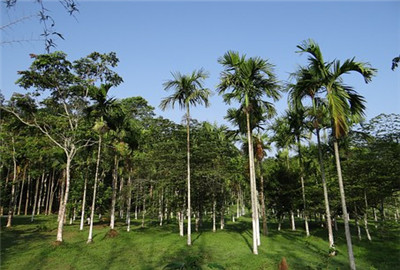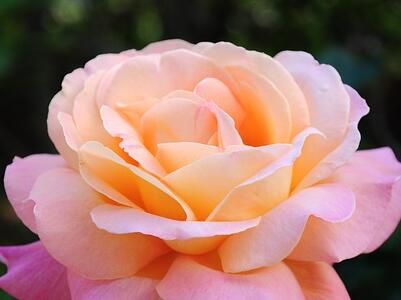Where can betel nut trees be planted? What's the difference between it and a palm tree?
We often see the packaged betel nut at the front desk of the store, but we seldom see the betel nut tree in our life. It is mainly distributed in Central Africa and Southeast Asia. It has been introduced and cultivated for 1500 years in China, and it is widely cultivated in Hainan and Taiwan provinces. Guangxi, Yunnan, Fujian and other provinces (regions) also have cultivation. So, where can betel nut trees be planted? According to the data, betel nut trees like high temperature, humid climate, fertilizer tolerance, cold tolerance, 16 ℃ defoliation phenomenon, 5 ℃ freeze injury, the most suitable growth temperature is 25-28 ℃. The area with annual rainfall of 1500-2200mm is suitable for growth. In the seedling stage, the shade degree is 50% and 60%, and the adult trees should be fully illuminated. It is suitable to be cultivated on sandy soil with deep soil layer and rich organic matter.

The difference between betel nut tree and palm tree
(1) Betelnut tree
① stem erect, treelike, more than 10 meters high, up to 30 meters, with obvious annular leaf scars.
The leaf cluster is born at the top of the stem, 1.3-2 m long, with numerous pinnae, glabrous on both sides, narrowly lanceolate, 30-60 cm long and 2.5-4 cm wide, the upper pinnae connate, and the tip irregularly toothed. Monoecious, inflorescences much branched, inflorescence rachis stout and compressed, branches zigzag, 25-30 cm long, distally slender, inserted 1 or 2 rows of male flowers, while female flowers solitary at the base of branches; male flowers small, sessile, usually solitary, rarely opposite, sepals ovate, less than 1 mm long, petals oblong, 4-6 mm long, 6 stamens, filaments short, 3 staminodes, linear pistillodes. Female flowers larger, sepals ovate, petals suborbicular, 1.2-1.5 cm long, staminodes 6, connate; ovary oblong. Fruit oblong or ovoid, 3-5 cm long, orange-yellow, mesocarp thick, fibrous. Seeds ovate, base truncated, endosperm chewy, embryo basal. Flowering and fruiting period is from March to April.
② betel nut trees are mainly distributed in Central Africa and Southeast Asia, such as India, Pakistan, Sri Lanka, Malay Peninsula, New Guinea, Indonesia, Philippines, Myanmar, Thailand, Vietnam, Cambodia and other countries. Introduction and cultivation in China has a history of 1500 years, with more cultivation in Hainan and Taiwan, as well as in Guangxi, Yunnan, Fujian and other provinces.
③ likes high temperature and humid climate, is tolerant to fertilizer and not resistant to cold. It has fallen leaves at 16 ℃ and frost damage at 5 ℃. The most suitable growth temperature is 25-28 ℃. The area with annual rainfall of 1500-2200mm is suitable for growth. In the seedling stage, the shade degree is 50% and 60%, and the adult trees should be fully illuminated. It is suitable to be cultivated on sandy soil with deep soil layer and rich organic matter. Seeds have the characteristics of post-ripening in fruit.
(2) Palm trees
① palm trees belong to evergreen trees. The trunk is cylindrical, up to 10m high, and the stem reaches 24cm. Often remains the old petiole and its lower part of the leaf, leaf Shu vertical dry top, shaped like a fan, suborbicular, stem 50-70cm, palmately lobed to the middle and lower part; petiole 40-100cm long, with obvious fine teeth on both sides. Dioecious, paniculate inflorescences axillary, flowers small and yellow. Drupe reniform-globose, stem ca. 1cm, blue-brown, glaucous. The flowering period is from April to May and the fruit is ripe from October to November.
② palms are native to China and are distributed in the south of Qinling Mountains except Xizang, from southern Shaanxi in the north, to Guangdong, Guangxi and Yunnan in the south, to Xizang in the west, and to Shanghai and Zhejiang in the east. It is widely distributed from the estuary of the Yangtze River to the west bank of the upper reaches of the Yangtze River.
③ palm is the most widely distributed species with the highest latitude in China. Like warm and humid climate, like light. Extremely cold-resistant, slightly shade-resistant. Suitable for good drainage, moist and fertile neutral, calcareous or slightly acidic soil, resistant to light salt and alkali, but also resistant to drought and moisture. Strong ability to resist air pollution. The wind is easy to fall and the growth is slow.
Time: 2019-04-11 Click:
- Prev

Symptoms and control methods of cucumber aphids and root nematodes (root knot nematodes)!
Cucumber, a widely cultivated annual trailing or climbing herb of Cucurbitaceae, is very prone to aphids and root nematodes in its growth process. Here are the symptoms and control methods of these two pests. Symptoms and control methods of aphids main symptoms: aphids are also called greasy insects
- Next

How long is the flowering period of gardenia? Is it harmful to the human body to put it in the bedroom? What if the leaves turn yellow?
Gardenia, also known as gardenia, yellow gardenia, gentian Rubiaceae. Belonging to Rubiaceae, it is an evergreen shrub with luxuriant branches and leaves, evergreen leaves and fragrant flowers. It is an important garden ornamental plant. How long does it bloom? Will it be harmful to the human body if it is put in the bedroom? What if the leaves turn yellow in the process of breeding?
Related
- Fuxing push coffee new agricultural production and marketing class: lack of small-scale processing plants
- Jujube rice field leisure farm deep ploughing Yilan for five years to create a space for organic food and play
- Nongyu Farm-A trial of organic papaya for brave women with advanced technology
- Four points for attention in the prevention and control of diseases and insect pests of edible fungi
- How to add nutrient solution to Edible Fungi
- Is there any good way to control edible fungus mites?
- Open Inoculation Technology of Edible Fungi
- Is there any clever way to use fertilizer for edible fungus in winter?
- What agents are used to kill the pathogens of edible fungi in the mushroom shed?
- Rapid drying of Edible Fungi

